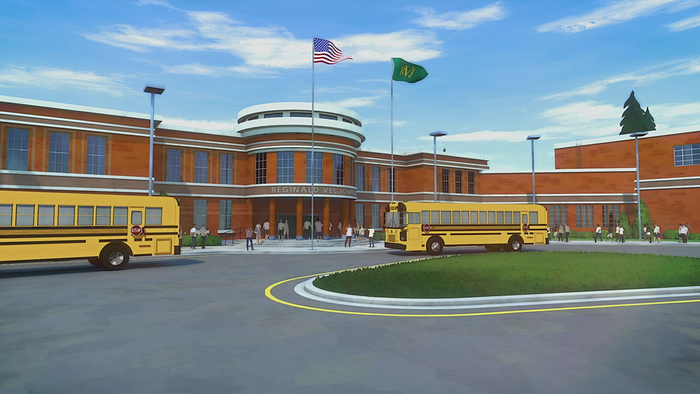This is the seventh in a series of episode reviews for the animated TV show Invincible, starting from the end and working backwards. See the overview here.
Last time I was a little nonplussed.
We arrive at the precipice, the penultimate instalment of Invincible viewed backwards. Game of Thrones, among other “prestige” TV shows, gave the penultimate episode a sense of importance: these are the episodes where Ned Stark dies, the narrative climax of our season-long train of events. This is a role that a second episode viewed in reverse order can’t really hope to fill — there are no grand revelations here, no sudden departures. Instead we get as close to a stock episode of the show as is possible, an artefact from a dimension where Invincible is a Saturday-morning cartoon, with every week a new villainous threat.

It’s an episode heaving at the seams with what you might call “world-building”, endless detailing of who knows who from where, why, and when— and if you were invested in the worthiness of the itemised lists of facts about fictional worlds, this would be a fine first episode to watch. I may have given an involuntary groan upon realising I was being shown an establishing shot of an American High School, straight out of Family Guy. The sketch we’re given here for the structure of the show, interestingly enough however, is more in line with Rick and Morty than it would appear — from both subsequent episodes and from promotional materials . Space travel and inter-dimensional visits are firmly within bounds.

What’s interesting are the lengths the creators go to present a best-foot-forwards view of what the show is able to do, despite being bound up in all this housekeeping. This could easily have been another episode #3, a sloppy plate of here’s-what-you-get where the inadequacy of individual elements is (hopefully) excused by the variety of them. In an appropriately backwards manner, the episode ends with a gorgeously rendered high-contrast sweep of action, as Omni-man destroys the art deco dimension. Reminiscent of nothing more than the original plan for the Superman: The Animated Series introduction, it’s a striking end to the episode, even if it does highlight that nothing of such indulgent ambition in the animation turns up again, save perhaps some of the scenes of detailed viscera.


The genius of Rick and Morty is in the recognition that the average viewer of a show like Rick and Morty is immersed in this kind of thing, and so is both likely to be very familiar with the tropes of sci-fi and fantasy — and be willing to explain them and/or read explanation of them at length on the internet. In this way, the show is free to engage in it’s iconic rapid-fire movement through different high-concept settings, pastiches and references. (This means the show is completely antithetical to ‘world-building’, by the by, and the writers are not afraid of nakedly poking fun at the legion of fans determined to fit the show into one unifying rational world.) The time-travelling aliens in this episode would fit easily into any given episode of Rick and Morty — we efficiently find out how they work (they move through time fast relative to us), the implications of that (they’ll be coming back) and then they come back. The basics fixed, we get some details that are going to cause us trouble: they advance very quickly technologically, but not so quickly that they cannot hold a grudge. And finally we get the twist: Omni-man can destroy their civilisation in the relative time it takes him to grow a small beard.

The trouble is that Rick and Morty isn’t just brutally efficient in the high-concept sci-fi settings; it’s also brutally efficient in the more prosaic stuff. Which is to say that most of this episode felt unnecessary to me, devoted to disseminating facts that are easily apparent from any given episode of the show — we get to find out that Eve goes to the same school as Mark, and she’s in a second-string hero gang led by an intolerable robot with tedious teammates. We get introduced to the space-CIA, exercising global authority under a constantly visible US flag. We’re introduced to Rex, who threads the needle between irritating and pathological a lot better here than he will in subsequent appearances (I can confidently state now that the scene where the “New Guardians” wash the blood off in episode 8 is, in full context of his season arc, still laughable).
As discussed in the previous episode (#3), every subsequent appearance from the detective demon has made him look less threatening and more incompetent. This episode does not break the pattern. He really does only feature for his five minutes of being-Rorschach.
Alien Seth Rogan is a pleasant diversion and nothing more — it was a little unclear to me whether or not he’d ultimately been to Earth before and what had happened? With the benefit of foresight I know he’s only coming back for some denouement at the end of the season anyway.

Because I don’t think I’ve mentioned it under any other episode heading, Sandra Oh (Debbie) really is top tier, along with JK Simmons (Omni-man) and Walton Goggins (Cecil). Between the three of them, the work-life balance scenes are consistently the most engaging scenes in the show.
I’ll take a moment to note the gorgeous design of the family house itself, a well-realised, well utilised set, despite being animated. It’s a house that at first appears open and welcoming, but the more time you spend with it the more it becomes clear that it’s a winding nest of secrets and cubby holes and invisible observers where the only constant is that wherever you are, someone could be watching. This episode may only be setting up the fundamentals, and to me that seems unnecessary, but it’s important to reflect on how much of those fundamentals — setting, casting, design— the show gets right.






